Test Your New Home
Be Prepared and Protect Yourself
We strongly recommend protecting yourself during your purchasing process; plan on setting aside some money to investing in these tests after your purchase offer has been accepted. Think of these tests as inexpensive insurance against any expensive or unpleasant surprises once you own the property. Understanding if you have a problem or not will ease your mind as to the quality of the home you're purchasing, and if a problem is identified, an opportunity to have the problem(s) corrected by the owner or negotiated to where you're comfortable in possessing the property. These tests are very inexpensive in comparison to the potential costs to correct once you have possession of the property and are in your best interest to have complete before you own. There are several partners who can perform these services that we can refer you to, our partners can also quote, manage, and mitigate any issues they identify for you.
CONTACT ABOUT OUR Services
HOME INSPECTIONS

Any building, large or small, is essentially a group of complex engineering systems bundled together. Significant effort goes into designing and constructing structures with separate electrical and plumbing systems, heating and cooling components with their distribution systems, the foundation, walls, flooring, roof and so on to then perform as a single housing solution together. Due to the complexities of these variable systems by themselves and working as a cohesive unit, various things are bound to fail or not quite perform as originally intended over time. This is especially true if maintenance is ignored or put off over time, or if systems are abused or damaged over the lifetime of the structure. Perhaps the different systems and components interact with each other in ways unforeseen and in a negative fashion. Sometimes these problems are minor, and sometimes they can be significant costing hundreds or even thousands of dollars to correct. Worst of all, some minor problems can escalate into major problems if left uncorrected or remain unknown.
With a thorough property evaluation, you can find out what the “state of health” of the property you are thinking of buying is before you buy. Inspectors will check the roof, basement, heating system, water heater, cooling system, structure, plumbing, electrical, insulation, appliances, building interior and exterior, decks, and many other aspects of the structure. They look for improper building practices, those items that require extensive or minor repairs or maintenance, items that are general maintenance issues, as well as fire and safety issues. However, a home inspection is not technically exhaustive and does not imply that every defect will be discovered. This is the first best investment that you can take in purchasing your new home. This is where we will be first notified of any health and safety issues and potential large capital expenses that we can negotiate before you close.
For more information on the importance of a Home Inspection, please be sure to visit For Your Protection: Get a Home Inspection from the Department of Housing and Urban Development
RADON
Radon is a cancer-causing, naturally occurring radioactive gas that can’t be seen, smelled, or tasted.
Radon is estimated to cause many thousands of deaths each year due to breathing air containing radon, which can cause lung cancer. In fact, the Surgeon General has warned that radon is the second leading cause of lung cancer in the United States today. Only smoking causes more lung cancer deaths, if you smoke and your home has high radon levels, your risk of lung cancer is especially high.
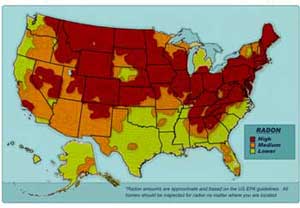
Radon can be found all over the U.S. Radon is the result of the natural breakdown of radioactive elements in our soil, rocks and water; which then gets into the air we breathe. It can get into any type of building — homes, offices, and schools — and result in a high indoor radon level. You and your family are most likely to get your greatest exposure at home, where you spend most of your time.
You should certainly test for radon. Testing is the only way to know if you and your family are at risk from radon, and testing is inexpensive and easy. Contact us for referrals of companies that can complete a radon test for you.
You can fix a radon problem. Radon reduction systems work and they are not very costly, some radon reduction systems can reduce radon levels in your home by up to 99%. Even very high levels can be reduced to acceptable levels, contact us for referrals to companies that can mitigate high radon levels to below EPA approved levels.
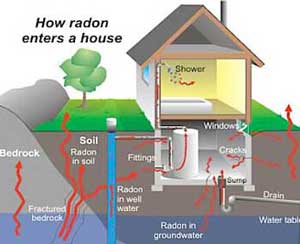
How Does Radon Get Into Your Home? Radon is a radioactive gas, it comes from the natural decay of uranium that is found in nearly all soils. It typically moves up through the ground to the air above and into your home through cracks and other holes in the foundation, radon from soil gas is generally the main cause of home radon problems. Your home traps radon inside, where it can build up; any home may have a radon problem. This means new and old homes, well-sealed and drafty homes, and homes with or without basements.
For more information on radon, please be sure to visit the Environmental Protection Agency's site A Citizen's Guide to Radon.
SEWER SCOPE
Understanding the condition of the underground sewer drain line and knowing the extent and location of a particular problem will be a key part of your decision in purchasing a home. There are several defective conditions that may exist-even in newer homes and not just older homes with clay pipes- that you'll want to understand and have corrected before you purchase your home; otherwise significant out of pocket expense may be the result should one of these conditions exist in your home after closing.

Low Areas: also known as a 'belly', these low areas can collect water and solid waste, causing poor flow through the pipe and can lead to back-up and damage to the pipe as it sags further.

Offsets: on some older piping, sections in the piping can separate, causing an offset in the piping to occur. Solid waste may not clear this offset, and waste water will seep into the surrounding soil, causing further settlement and eventual breakdown of the piping.

Tree Roots: small gaps in sections of piping can allow tree roots to enter the sewer line. As the roots grow, the pipe can break and crack, requiring repair. Minor tree root intrusion can be rooted and cleared on a regular basis, with minimal or no significant pipe damage. Assessing the amount of root intrusion is part of a sewer scope inspection.

Pipe Collapse: if extreme root intrusion has occurred or significant soil settlement has occurred around the area due to offsets or a low area, complete pipe collapse can occur, requiring full excavation and repair of the sewer line. While rare, this condition can be assessed as part of a sewer scope inspection.

Debris: Occasionally construction debris or other items can become lodged in the sewer line, preventing the flow of waste through the pipe.
LEAD
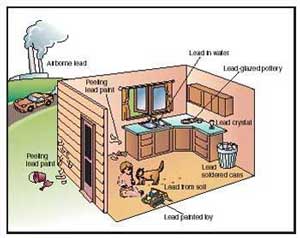
If your home was built before 1978, there is a good chance it may have lead-based paint. In 1978, the federal government banned consumer uses of lead-containing paint, but some states banned it even earlier. Lead from paint, including lead-contaminated dust, is one of the most common causes of lead poisoning. Lead paint is still present in millions of homes, sometimes under layers of newer paint. If the paint is in good shape, the lead paint is usually not a problem. Deteriorating lead-based paint (peeling, chipping, chalking, cracking, damaged, or damp) is a hazard and needs immediate attention from a certified professional.
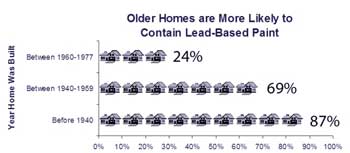
Lead is a naturally occurring element found in small amounts in the earth's crust. While it has some beneficial uses, it can be toxic to humans and animals causing negative health effects. Lead can be found in all parts of our environment - air, soil, water, and even the inside our homes. Much of our exposure comes from human activities, such as the use of fossil fuels including past use of leaded gasoline, some types of industrial facilities, and past use of lead-based paint in homes. Lead and lead compounds have been used in a wide variety of products found in and around our homes, including paint, ceramics, pipes & plumbing materials, solders, gasoline, batteries, ammunition, and cosmetics. Lead may enter the environment from these past and current uses.
For more information, be sure to reference the Environmental Protection Agency's website for additional reference material, and be sure to review the EPA pamphlet Protect Your Family From Lead In Your Home.
MOLD
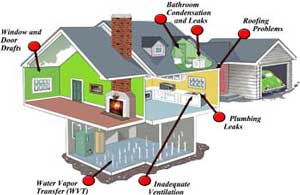
Molds are part of the natural environment, and they are everywhere just waiting for the right conditions to thrive. Outside, molds play an important part in nature by breaking down dead organic matter such as fallen leaves and dead trees; they are vital to the natural decay process and are needed. Indoors is naturally quite another story where we all prefer that mold growth should be avoided.
Mold spores can lay dormant through extremely inhospitable conditions, all mold needs is a source of moisture and for food to exist within a wide temperature range (between about 40° and 115° F) and mold will begin to grow. Building materials provide a source of food for mold, when the moisture content reaches 19% mold will grow and reproduce by means of tiny spores. These spores are invisible to the naked eye and float through our air indoors and outdoors. Mold may begin growing indoors when mold spores land on surfaces that are wet. There are a wide variety of molds, and none of them will grow without moisture.
Molds are usually not a problem indoors, unless mold spores land on a wet or damp spot and begin growing. Colonies of mold will establish within 48 hours, so if you have water damage, or soaking of building materials, it must be cleaned and dried within 48 hours to avoid any potential mold issues. When the moisture is dried up or removed via a repair, mold will no longer grow. When moldy materials are damaged or disturbed, spores can be released back into the air where people, pets and air currents spread spores.
Molds have the potential to cause health problems, as spores-both dead and alive-can cause allergic reactions. Molds produce allergens (substances that can cause allergic reactions), irritants, and in some cases, potentially toxic substances (mycotoxins). Inhaling or touching mold or mold spores may cause allergic reactions in some sensitive individuals. Allergic responses include hay fever-type symptoms, such as sneezing, runny nose, red eyes, and skin rash (dermatitis), allergic reactions to mold are common. Allergic responses may be immediate or delayed, molds may also cause asthma attacks in people with asthma who are allergic to mold. In addition, mold exposure can irritate the eyes, skin, nose, throat, and lungs of both mold-allergic and non-allergic people. Symptoms other than the allergic and irritant types are not commonly reported as a result of inhaling mold, and research on mold and its health effects are current and ongoing.
For more information, be sure to reference the Environmental Protection Agency's website for additional reference material, and be sure to review the EPA pamphlet A Brief Guide to Mold, Moisture, and your Home.
Areas We Serve
- Lafayette
- Louisville
- Boulder
- Erie
- Broomfield
- Longmont
- Westminster
- Denver
- Thornton
- Superior
- Brighton
- Northglenn
- Dacono
- Firestone
- Frederick
- Niwot
- Lochbuie
- Fort Lupton
- Commerce City

